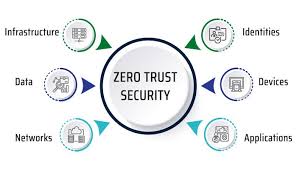Cyber threats lurk around every digital corner, trusting blindly is no longer an option. Enter zero trust architecture – a bold, game-changing approach to cybersecurity that assumes no one is trustworthy until proven otherwise. Gone are the days of perimeter-based defenses; zero trust is redefining how businesses protect their data, networks, and users. Let’s explore what zero trust architecture is, why it’s critical, and how it’s shaping the future of secure computing.
What Is Zero Trust Architecture ?
Zero trust architecture (ZTA) is a cybersecurity model built on a simple principle: trust no one, verify everything. Unlike traditional security models that assume users inside a network are safe, zero trust treats every user, device, and connection as a potential threat. It requires continuous verification of identities, strict access controls, and real-time monitoring to ensure only authorized entities access sensitive resources. Read more: https://blog.makaiindustry.com/2025/04/07/the-harsh-reality-of-cyber-attacks/
Think of it like a high-security vault: even if you’re inside the bank, you still need to prove your identity at every door, every time. Zero trust applies this mindset to your entire IT environment – whether it’s on-premises, in the cloud, or a hybrid setup.
Core Principles of Zero Trust
Zero trust architecture revolves around three key pillars:
- Verify Explicitly: Always authenticate and authorize users and devices based on all available data points, like identity, location, and device health.
- Least Privilege Access: Grant users only the access they need to do their job—no more, no less. This minimizes the damage if credentials are compromised.
- Assume Breach: Operate as if your network is already compromised. Monitor everything, limit lateral movement, and encrypt data to reduce risks.
Why Zero Trust Architecture Matters
Evolving Cyber Threats
Hackers are smarter than ever, using phishing, ransomware, and insider threats to bypass traditional defenses. Zero trust architecture counters these risks by requiring continuous validation, making it harder for attackers to gain a foothold.
Rise of Remote Work
With employees working from coffee shops, homes, and airports, the traditional network perimeter is gone. Zero trust ensures secure access to resources, no matter where users are or what devices they’re using.
Cloud and Hybrid Environments
As businesses adopt cloud and hybrid infrastructures, data is spread across multiple environments. Zero trust provides a unified security framework to protect assets, whether they’re in AWS, Azure, or an on-premises server.
Regulatory Compliance
Industries like finance, healthcare, and government face strict data privacy regulations. Zero trust helps meet compliance requirements by enforcing granular access controls and encrypting sensitive data.
Reducing Insider Threats
Not all threats come from outside. Zero trust limits what employees, contractors, or partners can access, reducing the risk of intentional or accidental data leaks.

Real-World Applications of Zero Trust
Healthcare: Hospitals use zero trust to secure patient records, ensuring only authorized staff access sensitive data while complying with HIPAA.
Finance: Banks implement zero trust to protect transactions and customer data, preventing unauthorized access even during remote banking.
Retail: E-commerce platforms leverage zero trust to safeguard payment systems and customer information, especially during high-traffic sales events.
Government: Agencies adopt zero trust to protect classified information, using continuous monitoring to detect suspicious activity.
Challenges of Implementing Zero Trust
While zero trust architecture is powerful, it’s not a plug-and-play solution. Here are some hurdles to consider:
Complexity: Shifting to zero trust requires rethinking your entire security framework, which can be resource-intensive.
Cost: Implementing tools like identity management systems, encryption, and monitoring solutions can be pricey.
User Experience: Strict verification processes may frustrate users if not balanced with usability.
Legacy Systems: Older infrastructure may not integrate easily with zero trust principles, requiring upgrades or workarounds.
Thankfully, modern tools like single sign-on (SSO), multi-factor authentication (MFA), and AI-driven threat detection are making zero trust more accessible.
How to Get Started with Zero Trust Architecture
Ready to embrace zero trust? Here’s a step-by-step guide to kick things off:
- Map Your Assets: Identify your critical data, applications, and users to understand what needs protection.
- Implement Strong Identity Verification: Use MFA and SSO to ensure only authorized users gain access.
- Enforce Least Privilege: Limit access rights based on roles and monitor for unusual activity.
- Secure Your Network: Use micro-segmentation to isolate workloads and encrypt data in transit and at rest.
- Monitor Continuously: Deploy tools like SIEM (Security Information and Event Management) to detect and respond to threats in real-time.
- Partner with Experts: Work with cybersecurity vendors like Okta, Palo Alto Networks, or CrowdStrike to streamline implementation.
The Future of Zero Trust
The cybersecurity landscape is evolving, and zero trust is leading the charge. By 2027, analysts predict that 60% of enterprises will adopt zero trust architecture as their primary security model. Trends like AI-driven security analytics, passwordless authentication, and integration with edge computing are making zero trust even more robust. As cyber threats grow more sophisticated, zero trust will remain a cornerstone of digital defense. Read more: https://learn.microsoft.com/en-us/security/zero-trust/zero-trust-overview
Zero trust architecture isn’t just a trend—it’s a necessity in today’s threat-filled world. By assuming no one is trustworthy and verifying everything, businesses can protect their data, empower remote work, and stay compliant. Whether you’re a small startup or a global enterprise, adopting zero trust will fortify your defenses and keep you one step ahead of cybercriminals.
Ready to make the leap to zero trust? Start by assessing your current security posture, and take the first step toward a safer, more secure future.
